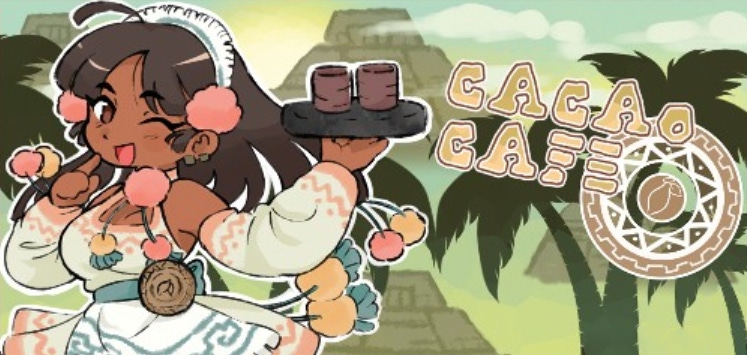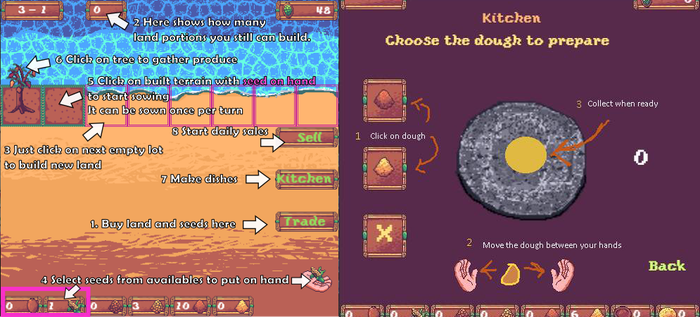
| Dig in! Exploring Cooking Mechanics in Games | ||
| Every day this week, Game Developer is serving up a feast of interviews, deep dives, and more digging into the evolution of Cooking in video games. | ||
| Browse Latest Articles | Submit your Blog | |
Exploring ancient Mexica culture through cooking in Cacao Cafe
Game Developer spoke with the creator of this historic cooking experience to learn about how they captured a culture while also working within the tight timelines of a game jam.

Cacao Cafe sees players cooking up treats and setting up shop for their customers, except they do so during the time of Maya and Aztec cultures, utilizing ancient cooking techniques to make their food.
Game Developer spoke with Sipsop from Creativa GS, creator of this historic cooking experience, to learn about what thoughts went into creating a cooking experience set in this era, the ways they created gameplay around ancient Mexica cooking techniques, and how they carefully selected the recipes players could use to capture their culture while also working within the tight timelines of a game jam.
Game Developer: Cacao Cafe sees players running their own café, but one steeped in ancient Mexica culture. What interested you about doing a cafe-style game set during this time period?
Sipsop, creator of Cacao Cafe: I had always wanted to make a game to honor the main Mesoamerican cultures: Maya and Aztec. For one reason or the other, I had previously had no time or even inspiration to make it.
For Cacao Cafe, many factors came together. There was a gamejam called "A Game By Its Cover" in 2020. We were in the middle of the pandemic and I had already participated in a previous version. This jam was about choosing a fictitious cartridge created by some artist somewhere in the world for "My Famicase Exhibition" and turn it into a real videogame. Among all the great creations, this one appeared and caught my attention: a cover made by Raia that seemed like the perfect pretext to finally create a game about Mesoamerican culture.
The player will use very old cooking techniques and tools while making the food for their café. What thoughts went into turning traditional Mexica cooking techniques and tools into gameplay mechanics?
For me, the very basic part of a simulation game is that it is based on real situations, objects, and events that could exist in that period of time, although obviously, some creative license has been taken.
Initially, I wanted to make a simple game of setting up a coffee shop somewhere in pre-Hispanic Mexico, making products, improving the store, adding more furniture, decorating, etc. But in reality, those places didn't exist and I didn't want to go too far out of the real and cultural context. Plus, there were already many games like that, so it didn't seem to me that it added anything new. It just changed the aesthetics of the game.
I thought: if I were a food merchant at that time, what would have been the actual process in that business? Fundamentally, it's the same way that actual people do food business in some traditional markets: they prepare their food at home, put it in baskets and go out to sell it in the streets around markets.
The objects still exist, the techniques are still valid... now the main question was: how do I turn it into a video game? That's when I thought the nicest way to show the techniques was to simulate the creation of the food, leaving the sales part like in the old games: where a random NPC comes and buys things based on your available stuff.

Image via SipSop.
Can you walk us through the creation of one of the specific cooking techniques, from conception to completion, as a gameplay mechanic and how you took the various steps of the recipe and turned them into player interactions?
In principle, you must obtain the seeds, as there was no currency in ancient Mesoamerica. Everything was done based on a bartering system, so you must trade with what was considered a kind of currency at that time: the dry cocoa seeds. The barter part is the simplest, just exchanging values between variables in a basic store interface.
Later, with your seeds, you must return to your land and sow them. In this case, I decided to use a system like in a farm game: you take the seed, you plant it, you obtain the product, the growth lasts just a few seconds and you can collect the product, leaving the chinampa (the area you grow your crops) free again but unusable for this cycle and renewable the following cycle.
I wanted the player to have control of his raw material, so I created a permanent interface at the top indicating the cycle and day, in the upper right corner the cocoa beans that you are carrying, and at the bottom the cocoa seeds, corn, the product of cocoa and corn; and cocoa and corn powder.
The steps are as follows to create a drinkable product, for example chocolatl or atolli. The first step, once the product is obtained, is to pulverize it using the metlapilli, which the players already have in their inventory. The other tools must be purchased. Next, to create the flour, in real life the product seeds are placed on the metate and the metlapilli is passed numerous times until the grains are pulverized.
This part is where I wanted the player to have an experience closer to a real simulation of the preparation and not just clicking the buttons, so I decided to simulate the process: the player must take the seed, put it on the metate and then move the metlapilli back and forth (up and down in game) with the mouse or touch. With each movement, the metlapilli passes over the grains and grinds them until you obtain flour, whether cocoa or corn.
I also wanted that, if the user had a large inventory of grains, they could continue the process, so when they touched the gourd, the flour would go into the inventory and they could restart the process, just like in real life.
Now, for hot chocolate, you need a pot. Then you need to turn on the heat and then the powder, but you also need to stir constantly so that it has a pleasant texture (it’s the same process for atole). This is how I wanted the player to continue moving with the game, so the first thing was to blow on the fire to light the embers. I decided to emulate the process by shaking the fan horizontally until the fire was lit. Then, the water in the pot would begin to boil. Now, the player must add the corn or cocoa powder to the water, which is done with a simple click
Finally, you must stir the pot using the grinder. In real life, this process produces foam in the chocolate or atole and is a slow process. To simulate it, I decided, as in the previous cases, to force the player to perform the stirring movement through the touch or the mouse vertically using the grinder right at the mouth of the pot.
In each process I had to make adjustments to the friction so that it felt more real. The fan, for example, moves with great agility, while the metatlapilli is difficult to control, I wanted the user to feel the weight of it. On the other hand, the grinder is lighter, however its collision is less precise, just as it should be in real life.
Perhaps the mechanic that I liked the least was that of creating the tortilla or the chocolate bar, which on the one hand requires passing the dough from one side to the other, but after trying several solutions it ended up like this moving the dough object from one hand to the other.
What thoughts went into choosing the recipes that you implemented into the game? Why were those recipes important to include?
At first I thought about making chocolate only since the game should be about cocoa, but in real life, people ate corn products more than chocolate, so I thought about integrating corn products, but because of the lack of time in a jam, I had to think about mechanics that could be shared by both grains to get more content with less programming. That's how I started selecting recipes.
Grinding is a common process, and since it was the first part of all processes and the base of the raw material, it had to be chosen obligatorily. Additionally, as it is a traditional process, I approved of it immediately.
After that, traditionally, both tortillas and chocolate bars are created in much the same way, by kneading and heating. I did not think of this process immediately, but rather I had to research what the traditional way of creating chocolate bars was. Upon discovering that it was very similar, I decided to also add this recipe. In this case, the cultural part also had to do with it, since the tortilla is the basis of many stews in traditional and even modern Mexican cuisine.
In the particular case of drinks, the process is also similar, as atole and chocolate differ very little in their preparation. So, I could add this process and it's funny to think that the first thing I should have selected for a coffee shop where they sell hot chocolate should be this one, but it was practically the last thing I chose and, in this case, it was definitely chosen because it had to be integrated, as it was implicit in the name of the game.
For all these examples, the techniques and tools are the same, so you could have twice as many products, using the same techniques and only changing the seeds and images.
Unlike chocolate, there are an infinite number of recipes that can be prepared with corn. I made a big list of dishes, however their preparation is more sophisticated or even unique, so adding these mechanics required creating many more interfaces, graphics, objects, ingredients, systems and processes, just to add one or perhaps two more products.
You also capture several different elements of Mexica culture in the farming techniques, stories, music, calendar dates, and language of the game. What design ideas went into creating such a comprehensive snapshot of ancient Mexica culture?
My intention was to transport the players, at least in their imagination, to that era. For the initial images, I decided to use a style similar to that of the codices, including some iconography from them. You see this, for example, in the text balloons.
For the scenarios, I was inspired by artistic conceptions from museums, especially archaeological zones. In the case of the characters, I looked for the most common typical costumes: not the most sophisticated ones, but those that could be seen on any morning at the flea market.
I wanted the game to have these cultural connotations. I wanted the players, through the game, to learn more about this culture. As I said before, I did not simply want to change the images of a café-running game, but make it an immersive experience. I think about the possibility that someone who plays it either already feels attracted to the Mexican culture or ends up wanting to know more.
To integrate this cultural part, I added the small tips that appear randomly and give the player some information about interesting facts related to culture, food, or both in each scene change. Researching and selecting these texts was a long process, but I really felt very happy to be able to include them.
And since the game has a time cycle, I wanted to base it on the actual dates that were used at that time. What was celebrated? How was it done? How could that interfere with the game character's life? What was the process for a pochteca to become a successful merchant recognized even in the emperor's court?
Last but not least: music. I was looking for and selecting music that worked for me, both because of the simplicity of the instruments and the roots. I also added some background sounds, frequent and random drumming, bustle of people, some flutes, and many birds. The main idea was to integrate all of these elements so that the game, no matter how simple it was, would take the player by the hand and show them what things could be like on a nice, sunny day at that time, all cohesive through the manufacturing and marketing of cocoa and corn products, which was the premise of the game.
What thoughts went into creating the visual style for the game? How did you work ancient Mexica culture into the game's art style alongside the various other mechanics and elements?
Mainly I wanted to capture the feel of an early console game, so I elected to pixelate and reduce the palette of the game. I really wanted the game to have that retro feel. I worked on experimenting with a reduced palette of colors, selecting the ones that best suited the experience. The game needed to have landscapes, blue skies, very green areas, and tones that would lend themselves to simulating corn and chocolate.
At the same time, I wanted to help the player to perceive the different textures in the materials, in the recipes, in the people, and in the landscapes I had all drawn in pixel art because I love it. It feels so retro, and I made a lot of changes from conception to the end product. For the decorations between scenes, my initial intention was to put the staggered fretwork that represents water or air for the Mesoamerican people, but in the sketch, they did not look very good, so I reduced the patterns until I found the concentric squares of the different color schemes that adorn most of the changes of scene.
For the characters, I wanted to keep the main aesthetics of the original Famicase image, with the anime-style girl, but I also wanted to do it more in the style of early Mexican comic artists.
How did it feel to explore your own culture so deeply with a game you created? What did it feel like to delve into the old cooking techniques of your culture?
When I was just a kid, we went to visit a town that still had many pre-Hispanic customs ingrained. For us kids from the city, it was very exciting to observe how our great-grandmother cooked. She had us shell the corn, and we all watched how she made the tortillas. It was a spectacle of color, heat, joy, and applause. Each tortilla must be kneaded between the hands by gently clapping and this produces a sound of applause. Taking one of those freshly made tortillas on a comal to your mouth was quite an experience.
Creating this game allowed me to remember those moments and by researching the holidays, the social classes, and the type of commerce, it made me feel great pride, but at the same time a desire to share with others, just like when you eat something delicious and you tell someone else: come try it, you'll like it!
That's how it was for me to make this game. It was to say, "Look what a wonderful thing this culture was, how much richness it contains. Let me show you through my game some of the things that I loved."
Regarding the techniques, well, it is something traditional here that you could observe in any visit to a rural market. The utensils and the techniques are the same. I knew the name of some objects in Spanish and it was very enriching to learn their name in Nahuatl.
It is an experience that I would recommend to any developer: promoting their own culture in a world that is increasingly open to sharing and knowing how to share this treasure that enriches all of humanity.
What do you hope the player takes away from steeping themselves in this culture and time period? From seeing the past and history of the Mexica culture, whether they already knew about it or not?
I would like it to be a mainly fun, relaxing experience.
A plus would be if the player could take away some curiosity to investigate or learn more about the culture and traditions of Mexico, not only from the past but current regional cultures all over the country. I hope that there is more curiosity to know those customs, social structures, religions, art, and, obviously, food. It is always a source of pride when other people are interested in your culture.
And perhaps, now that we have the almost free chance of seeing videos and images of archaeological and tourist sites without moving from your home, players can observe and have the possibility of marveling not only at the Mexica culture but at the richness that all the original peoples around the world have.
About the Author(s)
You May Also Like







.jpeg?width=700&auto=webp&quality=80&disable=upscale)








